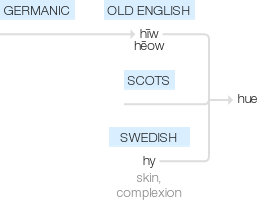Hue
Old English hīw, hēow (also ‘form, appearance’, obsolete except in Scots), of Germanic origin; related to Swedish hy ‘skin, complexion’. The sense ‘colour, shade’ dates from the mid 19th century.
wiktionary
From Middle English hewe, [1] from Old English hīew(“appearance, form, species, kind; apparition; hue, color; beauty; figure of speech”), from Proto-Germanic *hiwją(“hue, form, shape, appearance; mildew”), from Proto-Indo-European *kew-, *ḱew-(“skin, colour of the skin”) or *ḱey-(“grey, dark shade”). Cognate with Swedish hy(“complexion, skin”), Norwegian hy(“fluff, mold, skin”), Icelandic hégómi(“vanity”), Gothic 𐌷𐌹𐍅𐌹( hiwi, “form, show, appearance”). Compare also Sanskrit छवि(chavi, “cuticle, skin, hide; beauty, splendour”); Irish ceo(“fog”), Tocharian B kwele(“black, dark grey”), Lithuanian šývas(“light grey”), Albanian thinjë(“grey”), Sanskrit श्याव(śyāvá, “brown”).
From Old French hu or Old French heu, a hunting cry. [1]
etymonline
hue (n.1)
"color," Old English hiw "color; form, appearance; species, kind; beauty," earlier heow, hiow, from Proto-Germanic *hiwam (source also of Old Norse hy "bird's down," Swedish hy "skin, complexion," Gothic hiwi "form, appearance"), from PIE *kiwo-, suffixed form of root *kei- (2), a color adjective of broad application (source also of Sanskrit chawi "hide, skin, complexion, color, beauty, splendor," Lithuanian šyvas "white").
A common word in Old English, squeezed into obscurity after c. 1600 by color (n.) but revived 1850s in chemistry and chromatography, often in a distinctive sense in reference to the quality of color other than luminosity and chroma.
hue (n.2)
"a shouting," mid-13c., from Old French huee "outcry, noise, tumult; war or hunting cry," probably of imitative origin (compare French hue "gee!" a cry to horses). Hue and cry is late 13c. as an Anglo-French legal term meaning "outcry calling for pursuit of a felon" (the Medieval Latin version is huesium et clamor); extended sense of "cry of alarm" is 1580s.
